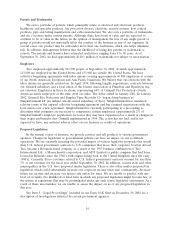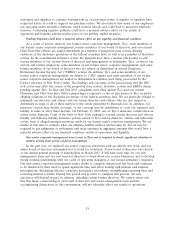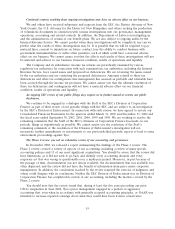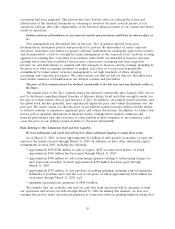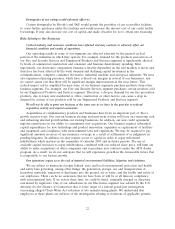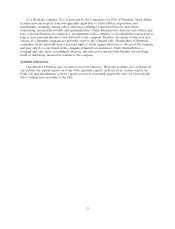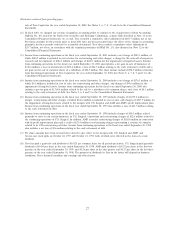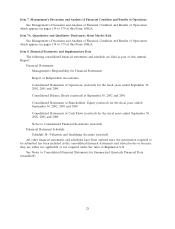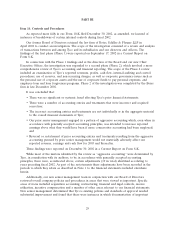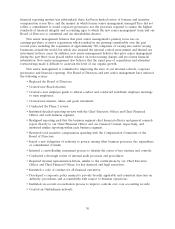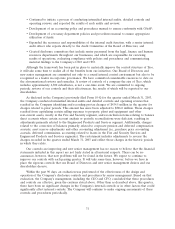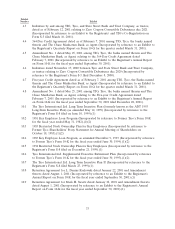ADT 2002 Annual Report Download - page 25
Download and view the complete annual report
Please find page 25 of the 2002 ADT annual report below. You can navigate through the pages in the report by either clicking on the pages listed below, or by using the keyword search tool below to find specific information within the annual report.and that two former supervisors at one of these plants, have pleaded guilty to felony violations of the
Clean Water Act.
Certain environmental laws assess liability on current or previous owners or operators of real
property for the cost of removal or remediation of hazardous substances at their properties or at
properties at which they have disposed of hazardous substances and costs to restore damage to natural
resources. In addition to clean-up costs resulting from environmental laws, private parties could bring
personal injury or other claims due to the presence of, or exposure to, hazardous substances used,
stored or disposed of by us or contained in our products.
We have been notified by the U.S. Environmental Protection Agency and certain foreign and state
environmental agencies that conditions at a number of sites where we and others disposed of hazardous
wastes require clean-up and other possible remedial action and may be the basis for monetary
sanctions. We also have a number of projects underway at several of our current and former
manufacturing facilities in order to comply with environmental laws. These projects relate to a variety
of activities, including radioactive materials decontamination and decommissioning, solvent and metal
contamination clean-up and oil spill equipment upgrades and replacement. These projects, some of
which are voluntary and some of which are required under applicable law, involve both remediation
expenses and capital improvements. In addition, we remain responsible for certain environmental issues
at manufacturing locations sold by us.
The ultimate cost of site cleanup is difficult to predict given the uncertainties regarding the extent
of the required cleanup, the interpretation of applicable laws and regulations and alternative cleanup
methods. We have concluded that it is probable that we will incur remedial costs in the range of
approximately $145 million to $440 million. As of March 31, 2003, we concluded that the best estimate
within this range is approximately $269 million, of which $32 million is included in accrued expenses
and other current liabilities and $237 million is included in other long-term liabilities on the
Consolidated Balance Sheet as of March 31, 2003. Environmental laws are complex, change frequently
and have tended to become more stringent over time. While we have budgeted for future capital and
operating expenditures to maintain compliance with such laws, we cannot assure you that our costs of
complying with current or future environmental protection and health and safety laws, or our liabilities
arising from past or future releases of, or exposures to, hazardous substances will not exceed our
estimates or adversely affect our financial condition and results of operations or that we will not be
subject to additional environmental claims for personal injury or cleanup in the future based on our
past, present or future business activities.
We may be required to recognize additional impairment charges.
Pursuant to GAAP, we are required to periodically assess our goodwill to determine if it is
impaired. Further disruptions to our business, protracted economic weakness, unexpected significant
declines in operating results of reporting units, continued downgrades in our credit ratings or additional
market capitalization declines may result in additional charges to goodwill and other asset impairments
in the future. Future impairment charges could substantially affect our reported earnings in the period
of such charge. In addition, such charges would reduce our consolidated net worth and our
shareholders’ equity, increasing our debt-to-total-capitalization ratio. Such reduction in consolidated net
worth and increase in debt as a percentage of total capitalization could result in a default under our
credit facilities.
We are subject to a variety of litigation in the course of our business that could cause an adverse effect
on our results of operations and financial condition.
In the ordinary course of business, we are subject to a significant amount of litigation, including
litigation alleging the infringement of intellectual property rights, litigation alleging anti-competitive
behavior and product liability litigation. Patent infringement and anti-trust laws permit successful
plaintiffs to recover treble damages. In addition, our Healthcare business is subject to regulation and
23





